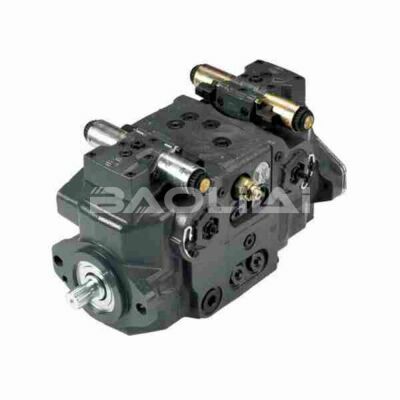Analysis of the key relationship between output pressure and torque of swash plate piston pump
The relationship between the output pressure and torque of a swashplate piston pump can be understood by considering how the pump operates. A swash plate piston pump is a type of axial piston pump often used in hydraulic systems. Here is a basic explanation of this relationship:
1.Swash plate mechanism:
In a swash plate piston pump, the swash plate is used to convert the rotational motion of the drive shaft into reciprocating motion of the plunger.
The swash plate is usually mounted at an angle to the axis of the drive shaft and tilts as the shaft rotates.
2. Plunger movement:
The tilt of the swash plate causes the plunger to reciprocate. As the swash plate tilts, the plunger moves in and out of the cylinder.
3. Pressure generation:
As the plunger moves inward, it pressurizes the hydraulic oil in the cylinder.
This pressurized fluid is then delivered to the pump outlet, creating output pressure.
4. Torque requirements:
The torque required to drive a pump is affected by factors such as hydraulic oil pressure, pump displacement, and mechanical losses within the pump.
H1-P-089-L-A-A-A3-C2-N-D3-H-G9-H5-L-25-L-25-D-M-18-PN-NNN-NNN H1P089LAAA3C2ND3HG9H5L25L25DM18PNNNNNNN
H1-P-089-L-A-A-A3-C2-B-D8-H-G1-NN-L-33-L-33-M-P-24-PN-NNN-NNN H1P089LAAA3C2BD8HG1NNL33L33MP24PNNNNNNN
H1-P-089-L-A-A-A3-C1-N-D8-K-F1-H2-L-28-L-28-M-P-24-P4-NNN-NNN H1P089LAAA3C1ND8KF1H2L28L28MP24P4NNNNNN
H1-P-089-L-A-A-A3-C1-N-D6-H-G1-H3-L-38-L-38-M-L-24-PN-NNN-NNN H1P089LAAA3C1ND6HG1H3L38L38ML24PNNNNNNN
H1-P-089-L-A-A-A3-C1-N-D3-H-F1-NN-L-45-L-45-M-M-24-PN-NNN-NNN H1P089LAAA3C1ND3HF1NNL45L45MM24PNNNNNNN
H1-P-089-L-A-A-A3-C1-N-D3-H-F1-NN-L-40-L-40-M-M-24-PN-NNN-NNN H1P089LAAA3C1ND3HF1NNL40L40MM24PNNNNNNN
H1-P-089-L-A-A-A3-C1-B-D3-H-G1-NN-L-43-L-43-M-M-24-PN-NNN-NNN H1P089LAAA3C1BD3HG1NNL43L43MM24PNNNNNNN
H1-P-089-L-A-A-A3-C1-B-D3-H-G1-H2-L-41-L-41-M-M-24-PN-NNN-NNN H1P089LAAA3C1BD3HG1H2L41L41MM24PNNNNNNN
H1-P-089-L-A-A-A2-C3-N-F5-H-G1-H6-L-35-L-35-D-P-30-PN-NNN-NNN H1P089LAAA2C3NF5HG1H6L35L35DP30PNNNNNNN
H1-P-089-L-A-A-A2-C3-N-F5-H-G1-H6-L-35-L-35-D-P-28-PN-NNN-NNN H1P089LAAA2C3NF5HG1H6L35L35DP28PNNNNNNN
H1-P-089-L-A-A-A2-C2-N-D8-H-G1-NN-L-15-L-33-M-P-24-PN-NNN-NNN H1P089LAAA2C2ND8HG1NNL15L33MP24PNNNNNNN
H1-P-089-L-A-A-A2-C2-N-D8-H-F1-H5-L-40-L-40-M-P-24-PN-NNN-NNN H1P089LAAA2C2ND8HF1H5L40L40MP24PNNNNNNN
H1-P-089-L-A-A-A2-C2-N-D8-H-F1-H3-K-45-K-45-N-E-34-PN-NNN-NNN H1P089LAAA2C2ND8HF1H3K45K45NE34PNNNNNNN
H1-P-089-L-A-A-A2-C2-N-D6-H-F1-H1-L-45-L-45-D-L-26-PN-NNN-NNN H1P089LAAA2C2ND6HF1H1L45L45DL26PNNNNNNN
H1-P-089-L-A-A-A2-C1-N-F5-H-G1-H6-L-42-L-42-N-E-24-PN-NNN-NNN H1P089LAAA2C1NF5HG1H6L42L42NE24PNNNNNNN
H1-P-089-L-A-A-A2-C1-N-F4-H-G1-H6-L-42-L-42-D-M-24-PN-NNN-NNN H1P089LAAA2C1NF4HG1H6L42L42DM24PNNNNNNN
H1-P-089-L-A-A-A2-C1-N-D8-H-G1-NN-L-42-L-42-N-E-24-PN-NNN-NNN H1P089LAAA2C1ND8HG1NNL42L42NE24PNNNNNNN
H1-P-089-L-A-A-A2-C1-N-D3-H-G1-NN-L-42-L-42-D-M-24-PN-NNN-NNN H1P089LAAA2C1ND3HG1NNL42L42DM24PNNNNNNN
H1-P-089-L-A-A-A2-C1-B-D6-H-G1-NN-L-38-L-38-M-L-24-PN-NNN-NNN H1P089LAAA2C1BD6HG1NNL38L38ML24PNNNNNNN
H1-P-078-R-A-A-R2-D7-C-F4-K-G9-H6-K-42-K-42-C-M-28-P2-NNN-D6F H1P078RAAR2D7CF4KG9H6K42K42CM28P2NNND6F
5. Relationship between output pressure and torque:
The output pressure of the pump is directly related to the force generated by the plunger, which in turn depends on the torque applied to the swash plate mechanism.
Assuming other factors such as pump efficiency and system resistance remain constant, higher torque applied to the swash plate will generally result in higher output pressure.
6. System features:
The relationship between output pressure and torque may also be affected by the characteristics of the hydraulic system to which the pump is connected.
System load, back pressure, and other factors can affect torque requirements and thus output pressure.
7. Variable pump:
Many swashplate piston pumps are designed with variable displacement, allowing control of the pump's output. The angle of the swash plate can be adjusted to change the stroke of the plunger.
In a variable displacement pump, the relationship between output pressure and torque can be more complex because it depends not only on the swash plate angle but also on the displacement.
8. Efficiency:
Pump efficiency plays a vital role in the relationship between output pressure and torque. The efficiency of a pump is the ratio of hydraulic power delivered to the fluid to the mechanical power supplied to the pump.
Pump inefficiencies, such as friction, leakage, and heat loss, may affect torque requirements for a given output pressure.

9. System dynamics:
The dynamic characteristics of the hydraulic system, including the presence of accumulators, valves, and other components, affect the relationship between output pressure and torque.
Rapid changes in system demand or the need for fast pressure response may require adjustments to the swashplate angle, affecting torque characteristics.
10.Control mechanism:
Some hydraulic systems contain control mechanisms, such as pressure compensators or electronic control units, to regulate pump output based on system requirements.
11.Load characteristics:
The load on the hydraulic system, including the resistance or force that needs to be overcome, can significantly affect the torque requirements of the pump.
Higher loads may require increased torque to maintain the desired output pressure, and changes in load conditions may cause dynamic changes in the relationship between torque and pressure.
12. Temperature effect:
The temperature of the hydraulic oil and the pump itself affects the viscosity of the fluid and thus the overall efficiency of the pump.
Temperature changes may alter the friction losses and viscosity of the fluid, thereby affecting the torque required to maintain a specific output pressure.
13. Cavitation and aeration:
Cavitation (the formation and collapse of air bubbles in the hydraulic fluid) and venting (the introduction of air into the system) can affect pump performance.
Both cavitation and aeration cause increased wear on pump components, potentially affecting torque requirements and output pressure.
H1-P-078-R-A-A-P9-C4-C-D6-K-G9-S1-L-42-L-42-C-L-32-P2-NNN-D6J H1P078RAAP9C4CD6KG9S1L42L42CL32P2NNND6J
H1-P-078-R-A-A-P9-C2-D-F6-K-G9-H6-L-45-L-45-C-L-26-P2-NNN-D6F H1P078RAAP9C2DF6KG9H6L45L45CL26P2NNND6F
H1-P-078-R-A-A-P9-C2-C-D8-K-G1-H3-L-42-L-42-C-P-28-P2-NNN-D6F H1P078RAAP9C2CD8KG1H3L42L42CP28P2NNND6F
H1-P-078-R-A-A-P8-C2-C-D6-K-G9-H3-L-42-L-42-C-L-26-P2-NNN-D5F H1P078RAAP8C2CD6KG9H3L42L42CL26P2NNND5F
H1-P-078-R-A-A-P7-C2-C-D6-K-F1-H3-L-45-L-45-C-L-30-P2-NNN-D4E H1P078RAAP7C2CD6KF1H3L45L45CL30P2NNND4E
H1-P-078-R-A-A-P6-C2-C-F5-K-G9-H6-K-45-K-45-N-E-28-P2-NNN-D3F H1P078RAAP6C2CF5KG9H6K45K45NE28P2NNND3F
H1-P-078-R-A-A-P6-C2-C-D8-K-G9-H5-K-45-K-45-N-E-28-P2-NNN-D3F H1P078RAAP6C2CD8KG9H5K45K45NE28P2NNND3F
H1-P-078-R-A-A-P6-C2-C-D8-K-G9-H3-L-42-L-42-C-P-26-P2-NNN-D3F H1P078RAAP6C2CD8KG9H3L42L42CP26P2NNND3F
H1-P-078-R-A-A-P6-C2-C-D3-K-G1-NN-L-45-L-45-C-M-30-P2-NNN-D3E H1P078RAAP6C2CD3KG1NNL45L45CM30P2NNND3E
H1-P-078-R-A-A-P6-C2-C-D3-K-G1-NN-L-45-L-45-C-M-26-P2-NNN-D3E H1P078RAAP6C2CD3KG1NNL45L45CM26P2NNND3E
H1-P-078-R-A-A-P6-C1-C-D6-K-G9-H3-L-45-L-45-C-L-30-P2-NNN-D3E H1P078RAAP6C1CD6KG9H3L45L45CL30P2NNND3E
H1-P-078-R-A-A-P6-C1-C-D6-K-F1-H5-L-42-L-42-C-L-26-P2-NNN-D3E H1P078RAAP6C1CD6KF1H5L42L42CL26P2NNND3E
H1-P-078-R-A-A-N2-C2-C-F5-H-G9-H6-L-40-L-40-N-E-30-P1-NNN-NNN H1P078RAAN2C2CF5HG9H6L40L40NE30P1NNNNNN
H1-P-078-R-A-A-N2-C2-C-D6-K-G9-S1-K-42-K-42-C-L-28-P2-NNN-NNN H1P078RAAN2C2CD6KG9S1K42K42CL28P2NNNNNN
H1-P-078-R-A-A-N2-C2-C-D3-H-G1-NN-L-35-L-35-C-M-26-P1-NNN-NNN H1P078RAAN2C2CD3HG1NNL35L35CM26P1NNNNNN
H1-P-078-R-A-A-N1-C2-C-D3-H-G9-H3-L-45-L-45-C-M-34-P1-NNN-NNN H1P078RAAN1C2CD3HG9H3L45L45CM34P1NNNNNN
H1-P-078-R-A-A-N1-C1-C-D8-H-G1-H3-K-40-K-40-C-P-26-P1-NNN-NNN H1P078RAAN1C1CD8HG1H3K40K40CP26P1NNNNNN
H1-P-078-R-A-A-M3-D4-N-D8-H-G9-H5-L-33-L-33-N-E-22-PN-NNN-NNN H1P078RAAM3D4ND8HG9H5L33L33NE22PNNNNNNN
H1-P-078-R-A-A-M2-D1-N-D8-H-G1-H5-L-42-L-42-N-E-22-H1-NNN-M00 H1P078RAAM2D1ND8HG1H5L42L42NE22H1NNNM00
H1-P-078-R-A-A-M2-C8-N-D3-H-G1-H3-L-42-L-42-C-M-24-PN-NNN-NNN H1P078RAAM2C8ND3HG1H3L42L42CM24PNNNNNNN
14. Maintenance and wearing:
As a swashplate piston pump operates over time, component wear can occur, affecting the mechanical efficiency of the pump.
Regular maintenance is essential to ensure that the pump continues to operate within its design parameters, minimizing unexpected changes in the relationship between torque and output pressure.
15. Fluid characteristics:
Hydraulic fluid characteristics, such as viscosity and compressibility, affect the overall efficiency of the pump.
Understanding how fluid properties interact with pump design is important to predict and adjust for changes in the relationship between torque and output pressure.
16. Noise and vibration:
In some applications, minimizing noise and vibration is critical. Changes in swash plate angle or mechanical components due to torque changes can affect the overall noise and vibration characteristics of the pump.
In summary, the relationship between output pressure and torque of a swashplate piston pump is a complex interplay of design factors, system dynamics, control mechanisms, and external influences. Analysis and prediction of this relationship requires a thorough understanding of the design of a specific pump, its intended application, and the dynamics of the hydraulic system in which it operates. Regular monitoring, maintenance and compliance with manufacturer specifications are critical to ensuring optimal performance throughout the life of the pump.
This article is published by the official website of Baolilai Hydraulics, please contact the author and indicate the source for reprinting:https://www.baolilai-pump.cn/news/1160.html






